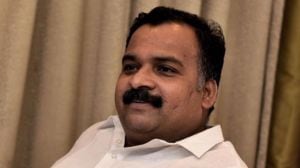For a Supreme Power
Kishori Amonkars concert was a singular experience of merging music with life.
Kishori Amonkars concert was a singular experience of merging music with life.
They say her voice is like a temple bell. In the 70s and 80s,it had the world queuing up outside concert halls to listen to the brazen genius of it. So on Sunday,when Delhis FICCI auditorium resonated with legendary Kishori Amonkars dulcet delivery of the mellow opening raga Bhimpalasi,her decades in music came to the fore,amplified by her throaty alaaps. Her music has aged,which can simply mean that the focus of it is not on virtuosity and experimenting to impress her audience. Now,at 81,Amonkars music merges with life itself.
But how does one go about evaluating an artiste whose contribution to the world of Indian classical music is beyond the idea of evaluation itself,whose music surpasses the ordinary and who has one of the most mellifluous voices in the world of Hindustani music? One does not.
In a concert organised by NKP Salve Foundation,when she strummed her surmandal,closed her eyes to sing the bandish Hey birha and delved into the elaborations around the madhyam,the audience slipped into a meditative trance. The prayerful raga is known to have relaxing qualities. It was here that the mike crackled. Everyone looked in anticipation. After all,she is known for her temper,having walked out of concerts if people coughed and stopped her recital midway once because there was a certain Farooq Abdullah chattering away in the front row. But Amonkar smiled instead,while the sound guys rushed in. Once the microphone was replaced,the sound was better.
Age may have affected her concerts a little she coughed throughout but there is still probably no one who can create those lightening speed akaar ki taans with such flourish. I dont sing the way I used to when I was 25, said Amonkar,who then sang her mother Mogubai Kurdikars composition in raag Jait Kalyan,showcasing the techniques of Jaipur Atrauli gharana.
The sound,despite little issues later,was still a problem for her. Its not working. You are wasting my time, she told the sound technicians.
We would have loved a Bhairavi from her but the audience wanted her to sing Basant Kedar and Amonkar obliged. One should not find patches of the two ragas. They both need to merge to sound like one, said Amonkar. One phrase melted into another as the raga finally climaxed. When she reached the ragas most sublime note by way of a complicated sapaat taan,something her students Nandini Bedkar and Tejashree Amonkar,also her granddaughter,could not repeat,the audience sighed with wahs and kya baat hai.
One felt that an artiste of the stature of Amonkar,who has always presented music on her own terms,giving more importance to the feeling,than the technical ways of it,seemed to be singing not for herself but for a supreme power. Her music was not for momentary pleasure. It stayed.
Humility is considered one of the most important virtues in Indian classical music. But when someone like Kishori Amonkar sings,temper aside,she should be allowed a little arrogance.
- 01
- 02
- 03
- 04
- 05































